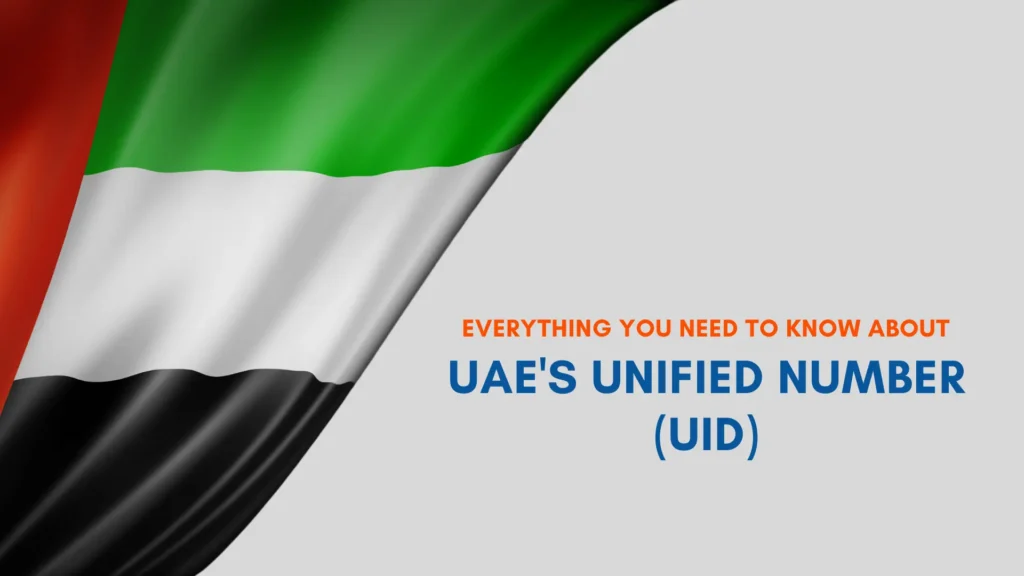
Demystifying the Unified Number (UID) in the UAE:
A Comprehensive Guide
Table of Contents
If you’re living in or moving to the UAE, you’ve probably heard about the Unified Number, or UID. It’s a crucial part of the country’s identity verification system. This guide will help you understand what the UID is, why it’s important, and how it impacts various aspects of life in the UAE.
The UID is more than just a number; it’s a key identifier that links all your records across various government entities in the UAE. From visa applications to healthcare and banking, the UID ensures that your identity is verified and recognized across the board.
Understanding your UID and its role can make navigating life in the UAE much smoother.
What is the Unified Number (UID)?

Definition and Explanation of the UID
The Unified Number (UID) is a unique 9-15 digit number assigned to each individual residing in the UAE. It is issued by the Federal Authority for Identity and Citizenship (ICA) and is found on your visa, Emirates ID, and other official documents.
The UID serves as a permanent identity number for expatriates and citizens alike, ensuring a streamlined and efficient identity management system.
Purpose and Significance of the UID
The primary purpose of the UID is to unify all personal records under a single identifier, simplifying administrative processes and enhancing security.
The UID plays a significant role in various government and private sector interactions, including visa processing, residency permits, healthcare services, employment records, and financial transactions.
Having a UID means that your identity can be easily verified and your records can be accurately maintained across different platforms and services.
How to Find Your UID?
Locating your UID might seem tricky at first, but it’s actually quite straightforward once you know where to look.
Here’s how you can find your UID on various documents and through online methods.
Steps to Locate the UID on Various Documents
Residency Visa: Your UID can be found on your residency visa, usually located near the top of the visa sticker in your passport. It might be labeled as “Unified Number” or simply “UID”.
Emirates ID: While the Emirates ID itself does not display the UID, you can find your UID in the documents issued alongside it, such as the Emirates ID application form or the visa approval notice.
Entry Permit: If you have an entry permit, the UID will be mentioned there. Look for a section labeled “Unified Number” or “UID”.
Visa Stamping Page: When your visa is stamped in your passport, the UID is typically listed on the page with your visa details.
Online Methods to Retrieve the UID
If you can’t locate your UID on physical documents, you can retrieve it online through these methods:
Federal Authority for Identity and Citizenship (ICA) Website:
- Visit the ICA’s official website.
- Navigate to the “Individual Services” section.
- Look for the “Check UID Status” service.
- Enter your passport number and other required details to retrieve your UID.
GDRFA (General Directorate of Residency and Foreigners Affairs) Website:
- Go to the GDRFA website for the specific emirate where you reside (e.g., Dubai, Abu Dhabi).
- Use the “Query” or “Check Status” service.
- Enter the necessary information, such as your passport number and nationality, to find your UID.
Smartphone Apps:
- Many government services in the UAE offer smartphone apps that allow you to access your UID and other details.
- Download the ICA or GDRFA app from your respective app store.
- Use the app’s services to query your UID by entering the required personal information.
By following these steps, you can easily locate your UID on various documents or retrieve it online, ensuring you have this important number on hand when needed.
Uses of the UID in the UAE
The Unified Number (UID) in the UAE is a vital piece of your personal identification puzzle. It serves as a unique identifier that streamlines various official processes and ensures smooth interactions with government and private entities.
Here’s how the UID is used across different sectors in the UAE:
Role of the UID in Government and Official Processes
Visa Applications and Renewals: Your UID is crucial when applying for or renewing your residency visa. It ensures that all your personal records are accurately linked and verified, simplifying the visa process.
Emirates ID Issuance: The UID is integral to the issuance and renewal of your Emirates ID. It helps in maintaining a unified record of your identity across multiple databases.
Immigration Control: At airports and borders, the UID helps immigration officials quickly access your records, ensuring smooth entry and exit procedures.
Legal Proceedings: For any legal matters, the UID ensures that your identity is accurately represented and all relevant records are easily accessible.
Importance in Legal, Immigration, and Financial Contexts
1- Usage of UID in Accessing Healthcare Services
In the UAE, the Unified Number (UID) plays a significant role in accessing healthcare services. When you visit a healthcare provider, your UID helps streamline the process by linking your medical records across different facilities. This ensures that:
- Accurate Record-Keeping: Your medical history, prescriptions, and treatment details are consistently updated and accessible to healthcare professionals.
- Seamless Service: Healthcare providers can quickly verify your identity, reducing wait times and improving overall efficiency.
- Efficient Referrals and Consultations: If you need to visit multiple specialists or facilities, your UID ensures that all relevant medical information is readily available, facilitating better-coordinated care.
Importance of UID for Health Insurance Purposes
The UID is crucial for managing health insurance in the UAE. Here’s why:
- Policy Enrollment and Claims: Insurance companies use the UID to verify your identity and process policy enrollments and claims accurately.
- Claim Verification: The UID helps insurers match your claims with your medical records, ensuring that claims are valid and correctly processed.
- Fraud Prevention: By linking your UID with your insurance records, the system helps prevent fraud and misuse of health insurance services.
2- Role of UID in Employment Verification and Processes
In the employment sector, the UID is essential for various verification processes:
- Employment Verification: Employers use the UID to verify your identity and employment history, ensuring compliance with labor laws and regulations.
- Work Permit and Visa Processing: The UID is linked with your work permit and residency visa, making it easier for employers to manage and renew your employment-related documentation.
- Record Management: The UID ensures that your employment records are accurately maintained and accessible, facilitating efficient human resource management.
How Employers Use UID for Official Documentation
Employers rely on the UID for several official documentation processes:
- Document Submission: When submitting official documents, such as employment contracts or visa applications, the UID helps link your records across various government systems.
- Salary and Benefits Administration: The UID is used to process payroll, manage benefits, and ensure that all financial transactions are accurately recorded.
- Compliance and Reporting: Employers use the UID to comply with labor regulations and report employment-related data to government authorities.
3- Necessity of UID for Opening Bank Accounts
The UID is a key requirement when opening a bank account in the UAE. Here’s why it’s important:
- Identity Verification: Banks use the UID to verify your identity and ensure that all personal and financial information is accurate and up-to-date.
- Account Opening Process: During the account opening process, your UID helps streamline the verification of your documents and personal details, making it easier to set up your account quickly and efficiently.
Importance in Financial Transactions and Services
The UID is crucial for various financial transactions and services:
- Transaction Verification: Banks use the UID to confirm your identity for transactions, ensuring security and preventing fraud.
- Service Access: The UID is used to access a range of financial services, including loans, credit cards, and investment accounts, making sure that all services are linked to your verified identity.
- Record Keeping: The UID helps banks maintain accurate records of your financial activities, facilitating better management of your accounts and services.
4- Government Services:
The UID is used across various government services, including driving license applications, utility connections, and more. It simplifies administrative processes and ensures that your records are consistent and up-to-date.
5- Educational Institutions:
For students, the UID helps educational institutions manage and verify student records, applications, and other administrative processes.
Enhancing Security and Efficiency
Fraud Prevention: The UID helps prevent identity fraud by ensuring that all your records are linked to a single, unique identifier, making it difficult for unauthorized individuals to access or manipulate your personal information.
Streamlined Processes: By unifying records across different sectors, the UID enhances the efficiency of various processes, reducing paperwork and administrative burdens.
In summary, the UID is a cornerstone of identity verification and record management in the UAE. Its widespread use across government and private sectors ensures that your interactions with various entities are secure, efficient, and hassle-free.
Recap of the Importance and Uses of the UID
The Unified Number (UID) in the UAE is a unique identifier assigned to residents for efficient identity verification and record management. It is used across various sectors, including healthcare, employment, and banking, to streamline processes and ensure accuracy.
The UID can be found on documents like residency visas and entry permits, and it plays a crucial role in accessing services, managing insurance claims, and verifying employment.
Common issues with the UID include incorrect details or difficulties in retrieval, but these can be resolved through official channels. Understanding and managing your UID effectively can help ensure smooth interactions with various services in the UAE.
Common Issues About UID You May Face and Solutions
While the Unified Number (UID) is a vital component of identity verification in the UAE, residents may encounter some common issues.
Here’s a look at these issues and practical solutions to resolve them.
Typical Problems Faced by Residents Regarding UID
Incorrect UID on Documents: Sometimes, the UID printed on official documents like visas or Emirates IDs may contain errors, which can cause issues with verification.
Lost or Forgotten UID: Residents might forget or lose their UID, making it challenging to access various services and complete official procedures.
Mismatch in UID Records: There may be discrepancies between the UID records held by different government departments or service providers, leading to confusion or delays.
Problems with UID Retrieval: Residents might face difficulties accessing their UID through online platforms or official channels due to technical issues or incorrect information.
Expired UID: In some cases, the UID might be linked to expired documents, leading to complications with renewals or updates.
Solutions and Steps to Resolve Common UID Issues
Incorrect UID on Documents
- Solution: Contact the issuing authority (e.g., ICA or GDRFA) to report the error. Provide copies of the incorrect document along with proof of correct UID (such as previous documents or official records) to facilitate corrections. Most authorities will guide you through the process of reissuing the corrected documents.
Lost or Forgotten UID
- Solution: Use online services provided by the ICA or GDRFA to retrieve your UID. You may need to enter personal details such as passport number and date of birth. If online retrieval is not possible, visit a customer service center or office of the ICA or GDRFA with identification documents to request assistance.
Mismatch in UID Records
- Solution: If you notice discrepancies in UID records across different departments, contact the respective offices to rectify the issue. You may need to provide supporting documents to demonstrate the correct UID. Ensure that all records are updated consistently to prevent future issues.
Problems with UID Retrieval
- Solution: If you experience difficulties retrieving your UID online, check that all entered information is accurate. Clear your browser’s cache and try again. If problems persist, reach out to the customer support team of the ICA or GDRFA for assistance.
Expired UID
- Solution: If your UID is associated with expired documents, initiate the renewal process for those documents through the relevant government authority. Once the documents are updated, your UID will be automatically aligned with the new records. For any issues during renewal, contact the respective authority for guidance.
By understanding these common issues and knowing how to address them, you can ensure that your UID-related processes are smooth and hassle-free. Always keep your UID information secure and up-to-date to avoid potential complications.
Uses of the UID in the UAE
While the Unified Number (UID) is a vital component of identity verification in the UAE, residents may encounter some common issues.
Here’s a look at these issues and practical solutions to resolve them.
Typical Problems Faced by Residents Regarding UID
Incorrect UID on Documents: Sometimes, the UID printed on official documents like visas or Emirates IDs may contain errors, which can cause issues with verification.
Lost or Forgotten UID: Residents might forget or lose their UID, making it challenging to access various services and complete official procedures.
Mismatch in UID Records: There may be discrepancies between the UID records held by different government departments or service providers, leading to confusion or delays.
Problems with UID Retrieval: Residents might face difficulties accessing their UID through online platforms or official channels due to technical issues or incorrect information.
Expired UID: In some cases, the UID might be linked to expired documents, leading to complications with renewals or updates.
Solutions and Steps to Resolve Common UID Issues
Incorrect UID on Documents
- Solution: Contact the issuing authority (e.g., ICA or GDRFA) to report the error. Provide copies of the incorrect document along with proof of correct UID (such as previous documents or official records) to facilitate corrections. Most authorities will guide you through the process of reissuing the corrected documents.
Lost or Forgotten UID
- Solution: Use online services provided by the ICA or GDRFA to retrieve your UID. You may need to enter personal details such as passport number and date of birth. If online retrieval is not possible, visit a customer service center or office of the ICA or GDRFA with identification documents to request assistance.
Mismatch in UID Records
- Solution: If you notice discrepancies in UID records across different departments, contact the respective offices to rectify the issue. You may need to provide supporting documents to demonstrate the correct UID. Ensure that all records are updated consistently to prevent future issues.
Problems with UID Retrieval
- Solution: If you experience difficulties retrieving your UID online, check that all entered information is accurate. Clear your browser’s cache and try again. If problems persist, reach out to the customer support team of the ICA or GDRFA for assistance.
Expired UID
- Solution: If your UID is associated with expired documents, initiate the renewal process for those documents through the relevant government authority. Once the documents are updated, your UID will be automatically aligned with the new records. For any issues during renewal, contact the respective authority for guidance.
By understanding these common issues and knowing how to address them, you can ensure that your UID-related processes are smooth and hassle-free. Always keep your UID information secure and up-to-date to avoid potential complications.
Related Articles
Are Your Ready To Get Golden Visa? Fill Below Form!
Your Questions Answered
Frequently Asked Questions
The Emirates ID is an official identification card issued by the UAE government to all citizens and residents. It is mandatory for accessing various government services, banking, and other essential activities.
You can apply for an Emirates ID through the Federal Authority for Identity and Citizenship (ICA) website or at any authorized typing center. You will need to provide required documents and complete the application form.
The processing time for an Emirates ID application can vary. Typically, it takes around 7-10 working days. However, it can take longer during peak periods or if additional verification is required.
To check your Emirates ID status, you will need your application number or Emirates ID number. These details are necessary to retrieve the status of your application from the ICA website.
If your application is rejected, review the reasons provided by the ICA. Common issues include incorrect or incomplete information. Correct the errors and reapply. You may also contact ICA support for further assistance.
Yes, you can check your Emirates ID status using your mobile phone. The ICA website is mobile-friendly, and you can follow the same steps as you would on a computer to check your status.
If your status shows ‘Processing,’ it means that your application is still being reviewed and processed by the ICA. You may need to wait a few more days for further updates.
To update your information, such as your address or contact details, visit the ICA website or an ICA service center. You will need to provide proof of the changes and complete the necessary forms.
If your Emirates ID is lost or stolen, report it immediately to the ICA. You can apply for a replacement ID through the ICA website or at an authorized typing center. There may be a fee for the replacement card.
You can contact ICA customer service by calling 6005-30003 or by emailing contactus@ica.gov.ae. For more detailed information and FAQs, you can also visit the ICA website’s support and help section.



